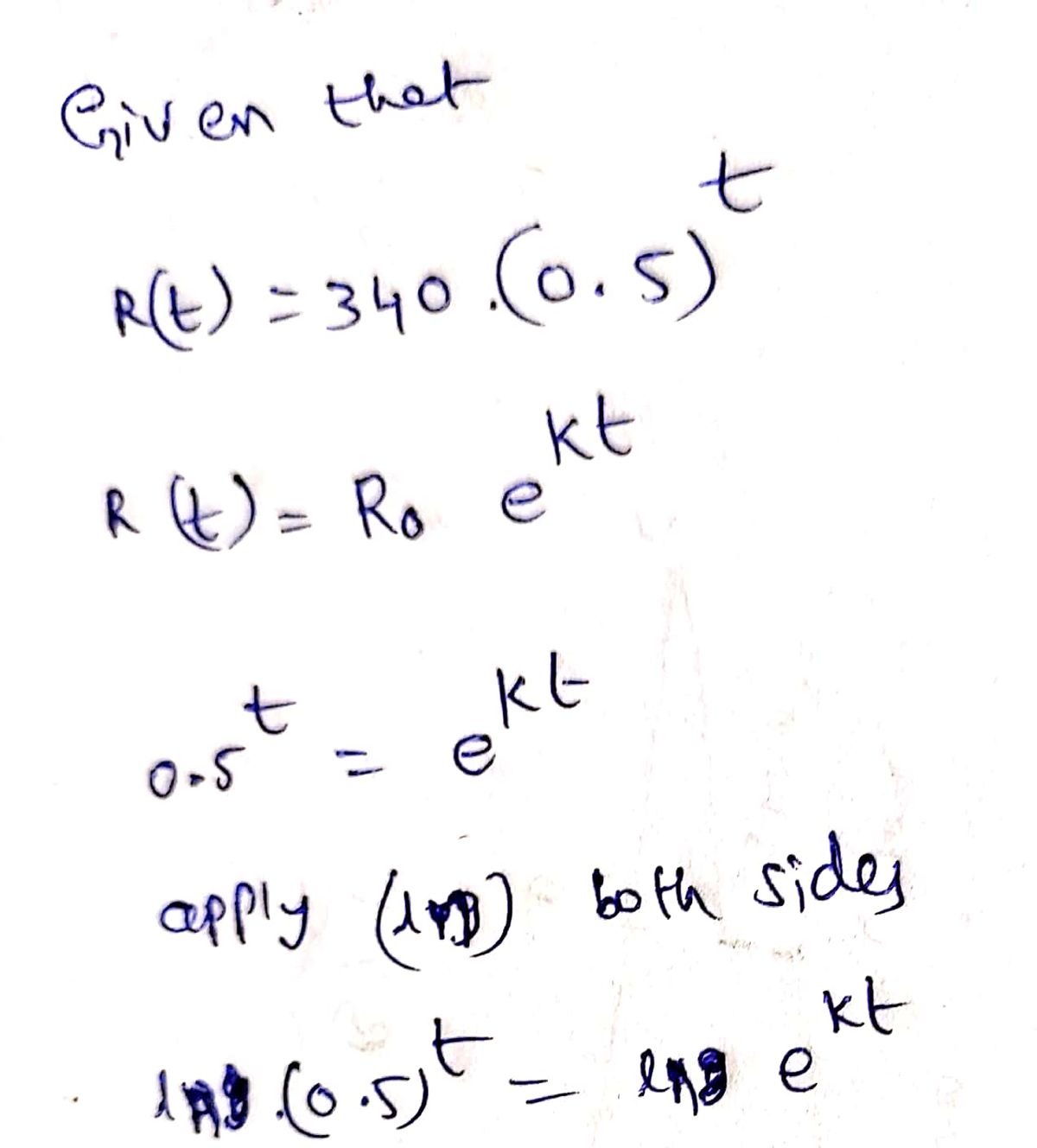You have not answered. R(t) = 340 - 0.5 Rewrite this in the form R(t) = Rgekt. Round k to 4 decimals. Ro = . and k Is this an exponential growth or exponential decay function? O A. Exponential decay OB. Exponential growth Answers
You have not answered. R(t) = 340 - 0.5 Rewrite this in the form R(t) = Rgekt. Round k to 4 decimals. Ro = . and k Is this an exponential growth or exponential decay function? O A. Exponential decay OB. Exponential growth Answers
Algebra and Trigonometry (6th Edition)
6th Edition
ISBN:9780134463216
Author:Robert F. Blitzer
Publisher:Robert F. Blitzer
ChapterP: Prerequisites: Fundamental Concepts Of Algebra
Section: Chapter Questions
Problem 1MCCP: In Exercises 1-25, simplify the given expression or perform the indicated operation (and simplify,...
Related questions
Question
![### Exponential Functions: Growth and Decay
**Given Function:**
\[ R(t) = 340 \cdot 0.5^t \]
**Task:**
Rewrite this function in the form:
\[ R(t) = R_0 e^{kt} \]
Round \( k \) to 4 decimal places.
* Inputs to fill:
* \( R_0 = \_\_\_\_\_ \)
* \( k = \_\_\_\_\_ \)
**Question:**
Determine whether the function represents exponential growth or decay.
- A. Exponential decay
- B. Exponential growth
**Answer Section:**
| | Answer |
|--------|--------|
| | |
| | |
| | |
**Important Note:**
When changing the base from a constant to the natural base \( e \), it is essential to determine:
- \( R_0 \) is the initial value (340 in this case).
- The constant 0.5 indicates a factor of decay, as it is less than 1.
Finally, calculate \( k \) using the properties of exponents and logarithms, particularly:
\[ 0.5 = e^k \]
Use this equation to find \( k \). Use the natural logarithm to solve for \( k \):
\[ k = \ln(0.5) \]
Once calculated, round \( k \) to four decimal places. Determine the nature of the function based on the value of the base (in this case, decay because 0.5 < 1).](/v2/_next/image?url=https%3A%2F%2Fcontent.bartleby.com%2Fqna-images%2Fquestion%2F71937467-3418-4168-ba3a-1f533ed3f436%2Fa0234d9c-800c-47ef-91bd-6d415459efb2%2Fkvewagd_processed.jpeg&w=3840&q=75)
Transcribed Image Text:### Exponential Functions: Growth and Decay
**Given Function:**
\[ R(t) = 340 \cdot 0.5^t \]
**Task:**
Rewrite this function in the form:
\[ R(t) = R_0 e^{kt} \]
Round \( k \) to 4 decimal places.
* Inputs to fill:
* \( R_0 = \_\_\_\_\_ \)
* \( k = \_\_\_\_\_ \)
**Question:**
Determine whether the function represents exponential growth or decay.
- A. Exponential decay
- B. Exponential growth
**Answer Section:**
| | Answer |
|--------|--------|
| | |
| | |
| | |
**Important Note:**
When changing the base from a constant to the natural base \( e \), it is essential to determine:
- \( R_0 \) is the initial value (340 in this case).
- The constant 0.5 indicates a factor of decay, as it is less than 1.
Finally, calculate \( k \) using the properties of exponents and logarithms, particularly:
\[ 0.5 = e^k \]
Use this equation to find \( k \). Use the natural logarithm to solve for \( k \):
\[ k = \ln(0.5) \]
Once calculated, round \( k \) to four decimal places. Determine the nature of the function based on the value of the base (in this case, decay because 0.5 < 1).
Expert Solution
Step 1

Step by step
Solved in 2 steps with 2 images

Knowledge Booster
Learn more about
Need a deep-dive on the concept behind this application? Look no further. Learn more about this topic, algebra and related others by exploring similar questions and additional content below.Recommended textbooks for you

Algebra and Trigonometry (6th Edition)
Algebra
ISBN:
9780134463216
Author:
Robert F. Blitzer
Publisher:
PEARSON

Contemporary Abstract Algebra
Algebra
ISBN:
9781305657960
Author:
Joseph Gallian
Publisher:
Cengage Learning

Linear Algebra: A Modern Introduction
Algebra
ISBN:
9781285463247
Author:
David Poole
Publisher:
Cengage Learning

Algebra and Trigonometry (6th Edition)
Algebra
ISBN:
9780134463216
Author:
Robert F. Blitzer
Publisher:
PEARSON

Contemporary Abstract Algebra
Algebra
ISBN:
9781305657960
Author:
Joseph Gallian
Publisher:
Cengage Learning

Linear Algebra: A Modern Introduction
Algebra
ISBN:
9781285463247
Author:
David Poole
Publisher:
Cengage Learning

Algebra And Trigonometry (11th Edition)
Algebra
ISBN:
9780135163078
Author:
Michael Sullivan
Publisher:
PEARSON

Introduction to Linear Algebra, Fifth Edition
Algebra
ISBN:
9780980232776
Author:
Gilbert Strang
Publisher:
Wellesley-Cambridge Press

College Algebra (Collegiate Math)
Algebra
ISBN:
9780077836344
Author:
Julie Miller, Donna Gerken
Publisher:
McGraw-Hill Education